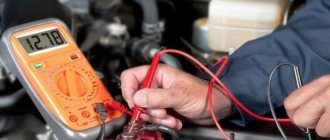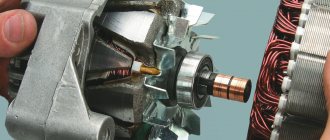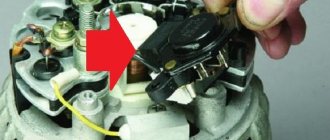Voltage drop when starting the engine is a fairly common problem, regardless of the type of power unit, as well as the make, model or class of the car. The voltage drop often manifests itself in such a way that at the moment the starter begins to rotate, the headlights sharply dim or go out, the dashboard lights lose their brightness, the radio turns off and restarts, etc.
A voltage drop can occur both when trying to start a cold internal combustion engine, and when starting an already warmed-up unit. As for the start itself, in some cases the starter actively turns for the first couple of seconds, then a certain “stutter” occurs. At this moment, the voltage drops, while the crankshaft continues to turn, but with great difficulty, but a serviceable engine usually starts.
There can be several reasons for such a malfunction, both obvious and easily removable, and hidden. In this article we will talk about why the voltage drops when starting the engine, as well as how to detect and fix the problem.
When starting the engine, the voltage drops: causes and diagnostics
Voltage drop when starting the engine is a fairly common problem, regardless of the type of power unit, as well as the make, model or class of the car. The voltage drop often manifests itself in such a way that at the moment the starter begins to rotate, the headlights sharply dim or go out, the dashboard lights lose their brightness, the radio turns off and restarts, etc.
There can be several reasons for such a malfunction, both obvious and easily removable, and hidden. In this article we will talk about why the voltage drops when starting the engine, as well as how to detect and fix the problem.
What to do if there is no charge, weak charge (battery is discharged)?
If the battery of your VAZ 2107 is discharged, then one of three elements may be “to blame”: the generator, the voltage regulator, the connections between them. Determining “who is to blame” can be very simple, even without additional equipment. How this article will help.
We carry out testing using standard equipment
To monitor the operation of the generator on the “seven” there are two instruments: a voltmeter and a control light on the instrument panel. With their help, you can track the cause of your troubles.
1) Turn on the ignition without turning on the starter
and look at the warning light. It should shine at full intensity, as in the photo. The voltmeter needle, normally, stands on the white part of the scale (photo). Let's say everything is OK - go to point 2 - start the engine.
The battery charge control lamp is on
Position of the voltmeter needle before starting the engine (ignition on)
The lamp does not light, the voltmeter needle remains at zero when the ignition is turned on.
Check fuse No. 10 in the mounting block. 99% of the time it will be burnt out. In this case, all other lamps on the instrument panel will also be de-energized. Replace it with the same one and test again. If the fuse burns out again, you need to look for the cause, that is, a short circuit. We check whether the wires from the generator are disconnected, whether the insulation is frayed somewhere, etc. Diagram 3 at this link
The lamp does not light up, the voltmeter needle shows normal
We check the wires on the generator to see if the wire has come loose from terminal “61”. If everything is normal there, you need to check whether there is a “plus” on this wire using a test lamp, an indicator screwdriver or a multimeter.
Terminal “61” of the VAZ-2107 generator
If there is a “plus” , we check the “tablet” (aka “chocolate”) and the generator.
There is no “plus”– you will have to remove the instrument panel and check the lamp. Replace the burnt out one. How to remove the panel, watch the video
2) Start the engine
The control lamp should go out, the voltmeter needle goes into the green sector and is located from the middle to the right edge (photo). If everything is so, then most likely the generator is working normally .
The voltmeter shows normal voltage (charging is present)
The lamp remains on or dims slightly
If you give it gas, it goes out at high speeds and lights up again when they decrease. The voltmeter needle is in the white sector and goes to the edge of the green when the speed increases. The generator output is faulty . The same conclusion if the lamp continues to light at any speed, and the voltmeter needle is in the white sector and even goes to red.
Voltage too low (motor running). Weak charge
3) If the generator seems to be working, but the battery is gradually discharged
Let's do one more check. We start the engine, turn on the heater fan and low beam, take the key to “10” and, loosening the negative terminal of the battery, remove it. An idling engine (about 900 rpm) should not stall. If the engine stops, put the terminal back in place and start it again. While holding the speed at 1200-1500, remove the terminal again. Has the engine stalled again? Then turn off the headlights, leave the heater fan on and repeat the test. Now the engine with the negative terminal disconnected from the battery continues to run. output works, but does not produce the required current, it needs to be repaired, the diode bridge will need to be replaced.
Note! During such a check, it is better and safer to work together. You cannot disconnect the battery terminal without at least turning on the heater fan or other load. A voltage surge at the time of shutdown can “burn” the electronic elements of the ignition systems. You need to be especially careful on a car with an injection engine.
Low voltage when starting the engine: how to find the cause
Let's start with the fact that the battery is not always the culprit of all troubles, although quite often reduced voltage occurs as a result of problems with the battery. In any case, before you start diagnosing a car regarding electrical parts, you must have a special auto tester (multimeter).
It is important that the device accurately measures certain parameters. As a rule, the functionality of the device should allow you to measure voltage, resistance, and current. At the same time, when troubleshooting voltage-related problems, you also need to take into account the crankshaft speed.
Checking the car battery
So, when diagnosing, you need to start by checking the battery, as well as the car generator. The condition of the battery is assessed by connecting the tester to the battery terminals. Normally, the voltage on the battery, taking into account the absence of load (all consumers are turned off), should be at least 12.6 V. A decrease in this indicator means that there is a partial undercharge or problems have arisen with the battery itself (sulfation of the plates, boiling off of the electrolyte, etc.).
You can also measure the voltage with a voltmeter, turning on the side lights and high beam headlights for the load. Typically, the discharge current under such a load (taking into account the installed halogen incandescent lamps) is about 5–6 A, and the voltage is about 11.5 V. If this is the case, then the battery is working and the problem needs to be looked for further.
Quick starter diagnostics
If we talk about the voltage directly at the moment of starting (when the starter turns), the voltage at the battery terminals should not fall below 9.5 V. In cases where this happens on a working and charged battery, it can be argued that a starter malfunction has occurred. In other words, the starter requires too much electrical energy when operating, which should not normally be the case.
Let us add that to measure the current you need an ammeter, which is connected to the gap. At the same time, it is highly not recommended to break the circuit in a car; also, not all ammeters are able to work correctly and record high readings that occur when the internal combustion engine is started.
For this reason, it is better to have a special motor tester for such tasks. The main advantage of the device is that the measurement accuracy is quite high, and there is no need to connect the tester to the break, since the device has separate sensors. These sensors are overhead and work even through wire insulation. These elements are capable of effectively recording changes in magnetic field strength when a current of one or another magnitude passes through the wires in the circuit.
Assessing the performance of a car generator
In cases where the battery has been previously checked and charged from the charger, and everything is in order with the starter, but the problem continues to appear, the generator needs diagnostics. The fact is that the generator recharges the battery after the engine starts. If the necessary recharging does not occur, then the battery quickly runs out, rapidly losing charge after just a couple of starts.
Then you can raise the engine speed, after which the charging voltage is also measured. For example, when the engine speed increases to 2 thousand rpm. The normal charge voltage ranges from almost 14 to 14.5 V. Next, the operation of the generator should be assessed under load. To do this, you will need to turn on the headlights again.
How to determine that the network voltage is insufficient?
The easiest way is to get information from the on-board computer. Most often, even inexpensive computers have a function for measuring this parameter. Most devices have a built-in alarm function for problems with the on-board electrical network. For example, if the voltage drops below 12V, a certain signal is triggered and a message is displayed with various content options. The following problems may also occur during the process:
- a decrease in the activity of the instrument panel lighting, as well as various light blocks, including dimensions, brake lights, turn signals, low and high beams, they dim;
- at idle speed the car begins to choke and even stalls, this is due to a lack of voltage, a fatal drop in the entire system occurs, fuel is not supplied;
- the radio tape recorder fails, it can simply turn off and then turn on itself if its connection is configured correctly, this happens when there is a power surge in the lower zones;
- when you turn on the interior blower fan or air conditioner, there is a noticeable effect on the engine, the speed drops, there is an effect on the quality of lighting by the optics;
- Voltage fluctuations are noticeable during warm-up and during normal idling of the engine, this can be seen from the flickering of lights and uneven engine operation, floating speed.
These are the kind of troubles that can make you think about problems in the electrical network. These are only visible problems, but in reality this trouble has a much wider range of influence. The reliability of the fuel pump, the normal functioning of the on-board computer and the absence of errors with it depend on the quality of the voltage in the network. Let's figure out exactly which components can lead to such troubles in your car.
What's the result?
As you can see, there can be many reasons why the voltage drops when starting the engine. Above were listed only the main points that should be paid attention to as part of the initial diagnosis.
It should also be noted that it is also necessary to check the condition of the battery terminals, as well as the “ground”, which over time tends to become covered with corrosion and plaque at the attachment points.
By the way, as far as weight is concerned, many car enthusiasts do the so-called “de-mining” of the engine to eliminate a number of similar problems. This procedure allows you to achieve stable operation of electrical equipment, and also minimizes losses and improves engine performance thanks to a constant and powerful spark on the spark plugs.
What is the purpose of demining the power unit and why? The main advantages of this solution are installing additional mass yourself.
The starter clicks and/or buzzes, but the engine does not turn over. The main causes of starter failures, diagnosing and troubleshooting them yourself.
Why the starter may not work after turning the key in the ignition. The main causes of starter malfunctions: bendix, traction relay, brushes, winding.
What to do if the starter turns, but the engine does not crank. Checking the power supply system, ignition, electronic control of the internal combustion engine, etc. Recommendations.
Why does the starter turn normally, but the engine does not catch and does not start? Main causes of malfunction, checking fuel supply and ignition systems. Adviсe.
The principle of operation and design of a car generator. The components of an alternator in a car: rotor, stator, windings, regulator.
Source
Battery charging circuit
For a general understanding of the reasons for overcharging, first consider the battery charging circuit diagram. And although it is structurally different on different cars, the general principle of construction is the same.
This circuit includes:
- Generator;
- Rectifier block (diode bridge);
- Relay regulator;
- Fuse box;
- Egnition lock;
- Charge indicator lamp;
- Battery
The recharging system works using the example of the VAZ 2106 and other cars from the VAZ classic series as follows: after starting the power plant, by means of a belt drive, the crankshaft begins to rotate the generator rotor, as a result of which this unit begins to generate electricity.
But since automobile generators use alternating current, the generated energy goes to the rectifier unit, where alternating current is converted into direct current.
After the rectifier unit, the electricity goes to the relay-regulator, whose task is to maintain the voltage in a given range.
After the regulator, the electrical energy passes through the circuit through the fuse box, the ignition switch and the charge indicator lamp, then returns to the output of the generator, and from there it is supplied to the battery.
The detailed diagram is shown below.
How I got rid of voltage sag on my Lada Priora. A simple and budget method.
I came across such a nuance that I came to the car in the morning and it wouldn’t start, the battery was dead.
This upset me and I began to figure out what was what.
The first thing I did was take the battery to charge, and without wasting any time, I went to check all the contacts and all the negatives.
I saw that the negatives were oxidized, so I decided to clean all the contacts.
In the morning I bring the battery, connect everything, start the car, I decided to check it with a multimeter
Whether the generator is working or not, I connect
13.7v,
well, I think it’s good. ( As I understand it, it really was a matter of bad contacts
).
About half a year passed, I decided to install a small subwoofer.
I bought everything, connected it, I drive and enjoy quality music.
I decided to connect the scanner to the car ( read the errors and look at the engine indicators).
I connected
the obd
scanner, reset the errors (
lambda failed
).
How to increase on-board voltage
Where and how is a diode placed in the LV circuit on the generator in order to increase the voltage in the car network and better charge the battery?
Here I propose a simple solution, raising the on-board voltage, without going anywhere in the car and its circuits. I searched in my archives and did not find the material from which I read this decision. “Structurally, voltage regulators have an upper limit of 13.6V. This is due to the “old” connection diagram, from which the new one was copied and “successfully improved”. In it, the necessary voltage from the on-board network, supplied to the regulator for comparison, passed through a chain of wires. On them it dropped to normal. According to the new scheme, we have a chronic undercharge of the battery. Which, with the arrival of winter, makes starting the engine in the cold quite problematic. But if you install a pre-heater, starting the engine will be much easier.
It should also be noted that the battery begins to absorb energy (charge) only when its temperature is above zero. Therefore, in winter, if you make short runs and the battery does not have time to warm up under the hood to at least zero (plus charging time), it will be constantly discharged. And soon it will die... It is believed that after starting the engine, in order for the battery to recover, you need to drive for at least 20 minutes. Just go, and not stand in traffic jams! How to increase the voltage in the network?
Very simple! It is necessary to make the regulator “think” that we have low voltage in the network. Thus, the generator will give us the missing volts. A diode will help us do this. In a generator with a built-in voltage regulator, you need to place a diode in the circuit, as shown in the figure.
How to equalize the generator voltage on a Priora
Stable voltage is the key to uninterrupted operation of automotive electrics. The regulator assembly is responsible for its alignment. This is an inexpensive and reliable part, but sometimes it breaks down and the current begins to drop low, jump or disappear.
Not every VAZ owner thinks about how many volts the generator should supply to the Priora battery. But this question is important - the charging speed of the battery, its service life and the general condition of the car’s electrics depend on the normal operation of the part.
Diode 242
I will briefly summarize the parameters here:
reverse voltage: from 50 to 100 V or higher forward current from 5 to 10A, with a voltage drop across the diode from 1 to 1.5 V.
Constant undercharging of the battery or its absolute discharge at the most inopportune moment is a headache for many car owners. One source of these problems may be the generator. But how to check it? Perhaps it's not his fault at all? Let's figure out together how much the generator must produce for the normal functioning of all car systems and maintaining the battery in a charged state.
How many volts should the generator produce?
The key parameter is voltage. The operating voltage of the Lada Priora generator is 14 Volts: this voltage should be produced by the generator on the Priora without and with air conditioning. A deviation from the nominal value to a lesser extent will lead to unstable operation or failure of the electrics, deterioration of performance, and to a greater extent it can cause burnout of circuits and blocks. If abnormalities occur (low current or too high), the device needs to be diagnosed and replaced, if necessary.
The second parameter is the current strength. On Priors there are generators with 115 amperes, 90, 80, etc. This depends on the year of manufacture of the car, body type and configuration. Models with air conditioning have higher power.
Photo source: https://primahim.ru/p361170614-generator-2170-115a.html
The generator is an electromechanical device, and the causes of its failures lie in both electrical and mechanical components. Common faults:
- damaged or worn pulley;
- wear of slip rings or brushes;
- a failed relay (regulator) of the voltage of the Priora generator;
- destruction of bearings;
- short circuit on the stator winding;
- physical damage to wires;
- diode bridge problems.
It should be borne in mind that voltage problems do not always indicate a breakdown of the generator itself. The reason may lie in the battery, wiring and other components.
Charging drops when the UAZ Patriot engine heats up
First GAZ Club - AllGAZ.ru > Tips (FAQ) > Our garage > Electrics
| As it warms up, the generator voltage drops! | ||
| Electrical All electrical questions |
| Search the forum |
| Search by tag |
| Advanced Search |
| Find all good messages |
| Search by diaries |
| Search by tag |
| Advanced Search |
| Search in gallery |
| Advanced Search |
| Page 1 of 5 | 1 | 2 | 3 | > | Last » |
| The following users (2) thanked them: |
after 10-15 minutes, it lasts until the end all the time! if you stop and turn it off, it still won’t start!
Added after 1 minute 7 seconds I also measured the voltage on the gene itself, about the same readings as on the battery terminals!
The battery sat on charge for a day, then I installed it, at first everything was fine, then it warmed up and the voltage dropped again! If the battery is dead, then there will be little voltage on the gene at the output of the thick wire? Can the gene produce low current due to a dead battery? The battery is really tampered with!
Added after 1 minute 31 seconds
If the bank's battery is shorted, theoretically yes. But in this case, the car should not start. If it starts, then it's not the battery.
Added after 1 minute 22 seconds
If the bank's battery is shorted, theoretically yes. But in this case, the car should not start. If it starts, then it's not the battery.
Added after 1 minute 22 seconds
Gena is not a carburetor, why are they afraid of him? I went through mine in one evening. It's more of a problem to remove/install it.
I have no strength to fight anymore, my hands give up at the word: remove and disassemble the gene!
Added after 18 minutes 41 seconds does anyone have any suggestions?
If the problem is still in the gene, then you can change the diode bridge, but it is unlikely. You can take it off and ring it, it shouldn’t ring when it’s cold, in the opposite direction, and in the direct direction too, in my opinion. Then you heat the bridge with a hairdryer or a thread to 50-80 degrees and call again, if it starts ringing, then go to the store. And touch Gennady, is he getting warm?
Signs of a faulty voltage regulator
The engine and auto electrics must receive constant current. The stabilizer maintains the uniformity of the network voltage coming from the generator, preventing it from falling or rising too much. Initially, this unit was made electromagnetic, but the relay (regulator) of the new model received a completely electronic semiconductor design. Often it is this part that causes voltage surges and sags.
The generator produces low voltage
In the case of a low level, the cause may be a breakdown or excessive wear of the graphite brushes of the regulator. Sometimes the generator on the Priora produces low voltage due to short circuits and open circuits. All this leads to a small current or its disappearance. In such cases, the node needs to be diagnosed and, possibly, the device needs to be replaced.
- dim headlights;
- turning off on-board equipment, radio;
- Battery drains quickly, its charging is poor.
Power surges
- fuse burnout;
- shaking of the voltmeter needle on the panel, if present;
- flashing headlights and interior lighting;
- “jerking” of the engine, including at idle.
How to repair a generator - important recommendations
In 80% of cases, the culprit of low or unstable voltage in the vehicle’s on-board network at idle speed is the generator or its equipment. For example, the voltage regulator may be the culprit. Replacing it does not cause any particular difficulties, but it can be difficult to choose an option that is suitable in all respects. In case of this breakdown, there are several effective repair methods that will bring the desired results:
- replacing the voltage regulator - it looks like a small black tablet on domestic cars and like a small module on top or on the side of the generator on foreign cars;
- checking the integrity of the electrical circuit - perhaps there is a break somewhere in the area of the generator, voltage is not supplied to important modules for normal operation of the car;
- generator replacement - the unit is also often replaced as a whole in order to avoid problems in the future; a number of manufacturers do not recommend repairing these units at all;
- repair of the generator with replacement of the diode bridge, which is responsible for the generated electricity in the car, as well as for its correct rectification and distribution throughout the network;
- replacing a battery that is excessively discharged and requires either high-quality charging or simply replacement, it is better to buy a new battery and not experiment with old parts.
This is how difficult the process of qualitatively eliminating problems with a generator and its systems looks like. If you have no idea how the electrical module in a car works, you should not undertake DIY repairs. An incorrect connection can cost you a lot. Burnt wiring, burned blocks and system modules will have to be replaced, and this often turns out to be an unbearable burden for your budget.
Watch a video diagnosing problems with a car generator:
How to check the generator voltage on a Priora
To measure, you will need a voltmeter, which determines the voltage level at the machine battery terminals.
- Start the car.
- Warm up to operating temperature.
- Turn on all energy consumers (heating, heated seats and windows, high beams, radio).
- Raise the gas pedal to 2500 rpm.
- Check the voltage of the Priora generator with a multimeter. You can check with a regular voltmeter, doing this between the “ground” and the B+ terminals of the generator, and at the terminals.
The device should show 13.8-14.4 V with slight deviations. If their value is too significant, one can judge the failure of the LV, worn brushes and other problems. A similar conclusion is drawn if the current begins to “jump”.
Photo source: https://www.drive2.com/l/7902681/
Next, turn off all electrical appliances and measure again. The normal value in such conditions is up to 14.5 Volts. If it is greater, a conclusion is drawn about a probable malfunction of the regulator. If the voltage of the Priora generator fluctuates, the unit needs additional checking.
Battery undercharging. How to solve a problem?
Battery undercharging. How to solve a problem?
Post by Stason232 » Sat Oct 27, 2012 17:36
Posted by Philicio » Sat Oct 27, 2012 6:06 pm
I came across this on AZLK 2141 (UMPO 1.7) generator 55a Niva 214th generator 80 A Now Patriot 2012 onwards. 120 a In all cases, I installed a three-level voltage regulator from Energomash.
Installed instead of the standard one without any problems in half an hour. In the “Normal 14.2 V” position with low beam + heater the maximum is actually on the battery 13.9
There is a nuance. The consumers are connected not to the generator stud, but to the terminal on the battery. That is, under heavy load we have a voltage drop on the generator-starter-battery wires of up to 0.3-0.4 V.
The generator-starter wire is quite thin. You can get confused and put an additional wire, 14 square meters, between the generator and the battery.
Posted by Philicio » Sat Oct 27, 2012 6:09 pm
Post by Stason232 » Sat Oct 27, 2012 18:43
Post by luchsergey » Sat Oct 27, 2012 19:44
On the third car I installed the diode and forgot about the undercharging, the need to recharge the battery on the table at home in winter, and in general the need to check it at least once a year - because it became unnecessary, no matter how much I tried.
your option was my second:
This is the third option on the board:
Regulator replacement
If the diagnostics confirm that the relay is “replaceable,” you can install a working one yourself. For this you will need:
- New launch vehicle with brush assembly. Good samples are made in Russia, their price is low and they are highly reliable;
- Set of tools: keys for 13 and 8, a head with a knob for 10, a slotted screwdriver.
Progress
There are two replacement methods:
- with removal of the generator;
- without removal.
The first method simplifies the process, but on Priors with air conditioning, access to the required areas can be difficult. Actions after dismantling the device:
- Remove the plastic cover of the Lada Priora regulator.
- Remove the power plug.
- Unscrew a couple of fasteners.
- Use a wrench to remove the retaining bolt.
- Remove the old LV, install the new one, connect and reassemble everything in reverse order.
There is a way without removal - you can get to the block through the headlight or bypass the air filter by sliding it by hand. There are many video reviews dedicated to this operation on YouTube and thematic forums.
Features of the circuit
The above is a general diagram of the circuit, without details, but it is enough to understand how everything works. Now about the features of battery recharging.
The generator cannot independently regulate the parameters of the generated electricity, so the output voltage from it varies, and in a significant range, it depends on the crankshaft speed and the load in the on-board circuit. That is, the battery is essentially constantly being recharged while the generator is generating electricity.
In order for the battery to accept a charge, you need to apply a voltage to it slightly higher than the nominal value of the battery itself. The input voltage on the battery differs on different cars, but in general, this figure is in the range of 13.9-14.5 V.
It is at this voltage that the battery can “take” a charge. If the voltage is lower, the battery will be undercharged, and if the voltage is higher, it will be overcharged. Both situations have a negative impact on the battery.
The generator produces a voltage with a high value, and in order to maintain it in the circuit within the required limits, a relay regulator is included in the circuit.
On some models, this element is included in the design of the generator and is combined with a brush assembly (the most common design) or is a separate unit (found, for example, on the VAZ of the classic family).











